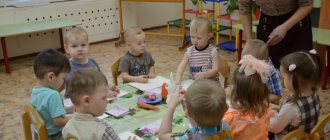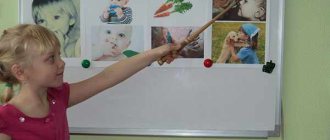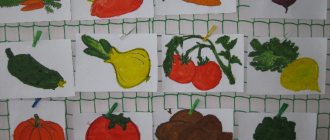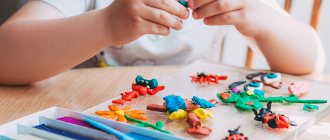This course is aimed at the comprehensive development of a child aged 1 to 2 years.
We place our main emphasis on the intellectual direction - teaching reading and mathematics, developing speech, studying the world around us, developing attention, memory, logic, and thinking. However, the course also contains other elements - creative crafts, listening to classical music, dynamic pauses aimed at developing the child’s gross motor skills.
- Course duration – 10 months (80 lessons)
- Frequency – 2 times a week
- Lesson duration – 50 minutes
- Children study with mothers
- The set includes 80 notes with illustrations and music files.
Features of our notes
№1. Many children's centers operate according to a plan that is largely focused on paperwork. Fruits are studied on cards, seasons too, clothes on a “printout”.
We work differently. A child can go through fruits and vegetables on the cards as much as he wants, but if in one lesson the child “digs” carrots, beets, onions, potatoes from a tray with real soil, in the next lesson he “undresses” the cabbage and divides the head of garlic into cloves, and in the third During the lesson, you will make a vinaigrette, the topic will be absorbed much better.
No. 2. Each summary has 2 variations - for children 1-1.5 years old and 1.5-2 years old . Early childhood development teachers know the huge difference between one-year-old and one-and-a-half-year-old children. Therefore, the difficulty of the exercises for them is different: when two-year-olds cut boiled vegetables for salad with plastic knives, one-year-olds simply pound boiled potatoes.
No. 3. Our notes are based on beautiful and proven methods . For the “Reading” block we use the work of Nikolai Aleksandrovich Zaitsev, for “Development of fine motor skills of the hand” and “The world around us” we take elements from Maria Montessori’s system, and in musical and rhythmic pauses we use the cute compositions of Ekaterina Zheleznova.
Many other modern authors also provide “food” for composing lessons. However, none of the techniques becomes dominant in the lesson. All material is passed through the experience of our teachers and supplemented by their developments.
№4. Our notes are equipped with illustrations, the lion's share of which were created by the designer specifically for our curriculum.
No. 5. We have thematically integrated classes . If the theme of today's lesson is “autumn,” then all lesson blocks, including mathematics and reading, are permeated with autumn themes. The lesson completely immerses you in the study of a particular area.
Classes for children 1-1.5 years old
Don't let this word scare you - classes. You will play with your child as usual, but this game will be educational, will promote speech development, and enrich your baby with new sensations, knowledge, and concepts. And most importantly, you will decide what to do with a 1.5 year old child. The proposed games-activities use observations during a walk, where the child saw a chicken or a cat, a dog, a goose, a cow, etc. The child can also be introduced to these animals through pictures.
Hide and seek with toys
1st option
. After showing and naming a familiar toy several times, place it next to it and cover it with a scarf. Throwing away the scarf, you exclaim: “Wow-woof!” Again you cover the toy with a scarf - where is the “woof-woof?” Open it again, etc. Then the baby takes off the scarf, finds a toy, and his joy knows no bounds. How many new sounds and syllables will your baby pronounce during such a game!
2nd option
. Select pictures from “Children's Lotto” depicting familiar animals or birds. Show one of them, encouraging them to repeat what it is. When the child begins to recognize the picture, place another one next to this picture. “Where is mmoo?” - you ask, forcing the baby to find the cow. Gradually complicating the task, increasing the number of pictures, offer to find the necessary one among them.
Feed the dog
Place a toy saucer, dog, cat, cow, etc. next to it. “Now let’s feed the dog. Who drinks milk? Etc. The proposed games not only expand the child’s ability to understand the world around him, but also stimulate the pronunciation of simplified words and prepare him for speech.
Game with clothespins
Take a set of clothespins and show your child how they can be used in interesting ways. For example, you can put it on a piece of paper or attach one to the other. Parents can cut out a hedgehog or a little man from paper and instead of hair or thorns, attach clothespins one after another.
Wonderful pouch
Sew a small (preferably colored, bright) bag, put plastic or rubber toys familiar to the child in it - a cow, a dog, a cat, a goat, etc. Take out the toys one at a time, show the baby and name them, imitating the sounds of the animals. Then invite him to repeat it all himself.
When taking toys out of the bag and showing the child, ask: “What is this?” If he doesn’t know, tell him the answer and let him repeat after you.
Place several toys around the room and encourage your child to find a specific toy and give it to you. He must bring it and name it. This way your child will learn to carry out the order: “Bring it and name it.”
Learn to understand the meaning of the words “give”, “call”. Show with a gesture. The child first imitates a gesture, and then imitates a word.
The game “Wonderful Bag” interests the child in the moment of surprise contained in it, and this helps him learn the names of toys, objects that he or you take out of the bag for him.
Who's doing what
This game expands awareness of the environment and develops active speech (teaches the names of objects), and also contributes to the development of story-based play. This is very important for the development of a child's imagination. Select 7-8 pictures that depict children or adults performing some action (with which your child is already familiar). For example: a girl puts a doll to bed, a woman wipes the dishes, a boy feeds pigeons, throws a ball, a girl feeds fish in an aquarium or a jar, a hairdresser gives a boy a haircut, a doctor treats a child, etc. Accordingly, take toys or real things so that the child can, using them, depict what is shown in the picture.
It is important not only to select all the objects according to the content of the picture, but also to name them and actions with them. These same pictures can also be used as a selection for poetry. For example, "Fish"
:
The jar contains clean water.
Let's put the fish there.
There will be fish playing there,
Swim, wag your tail,
Pick up bread crumbs.
Let him sing along, let him develop the ability for auditory concentration and the perception of artistic words.
Show your child the picture “Cat with Kittens” and ask who it is. Yes, this is a cat, and this is a kitten, he is red with white spots. This is also a kitten, he is gray. And who is this? Yes, and this is a kitten, he is white with black spots. This picture shows a cat with kittens...
Look how big the cat is, and what are the kittens?.. That’s right, the kittens are small. Your story about a cat and kittens will look something like this: “Now listen to what I tell you about a cat and little kittens. The cat loved her kittens very much and often played with them. Once they got so naughty that they knocked over grandma’s basket of threads. A ball of thread fell out of the basket and rolled across the floor. The kittens rushed to catch up with him and began to play with him. But soon they got tired. The big cat lay down on the rug, she is resting. The little white kitten also lay down next to the cat and fell asleep sweetly. And what did the little gray kitten do?.. That’s right, he went up to the plate and began to lap up the milk. Look how pink his tongue is! And only the red-haired kitten keeps playing and playing with the ball. He is the most cheerful and playful."
If there is a cat in the house, ask your child: “Do you love our cat? See how she plays. The cat has a tail and whiskers. What kind of mustache does she have? - Big ones. - Right. So you examined and told us about our cat, and now let’s play with her.” Usually children really like this game. Show your child a piece of meat wrapped in paper on a string. Let your cat smell the paper and then start playing with it.
While playing, focus your child’s attention on how the cat runs after the piece of paper, how it jumps up and deftly grabs it: “Look, it’s putting out its claws.” Let your child play. “Look how big the cat’s claws are, she’s holding the piece of paper tightly with them.” Raise the piece of paper high so that the cat cannot reach it. The cat begins to meow. Say: “The cat is asking for food, we need to feed her meat. (Give a larger piece, otherwise the cat will immediately swallow it). How does a cat eat meat?.. Look, she chews meat with her teeth. Now I will give her milk... Does she like milk? The cat laps milk. Look how pink her tongue is!”... If the cat starts washing itself after eating, draw the child’s attention to this. Then take the cat on your lap and say: “Now our cat will sleep. Where are her eyes?.. Yes, she closed them; listen to the cat purr... The cat fell asleep. Let’s stand quietly and take her to her place.”
Like our cat
The fur coat is very good.
Like a cat's mustache
Amazingly beautiful.
Bold eyes
The teeth are white.
Say these words tenderly; the child caresses her. Repeat several times, and the child will begin to persuade, and then remember them.
Using a keyboard or calculator
Don't let the name of the game scare you. This includes an old keyboard or calculator, if you have one. Give it to the child, let him press to his heart’s content, and parents will have time to relax and drink a cup of tea.
Cereals
Pour different cereals into a large bowl; children love to put their hands in such a container and feel for different textures. This kind of entertainment helps develop fine motor skills in a child.
Reading fairy tales and poems
Select age-appropriate literature and read to your child. You should not think that children at 1 and 1.5 years old do not remember anything. This opinion is wrong; in the future, children will begin to remember and pronounce the sounds they heard while reading.
Bubble
You can buy soap bubbles or make your own. This activity will keep your one-year-old baby engaged for a long time.
Modeling from modulin or kinetic sand
Children of any age love to sculpt. And after the first year of life, children do not get tired of creating their own creations from a special modeling paste. The same applies to kinetic sand - you want to scatter it, you want to sculpt it. If parents are worried about cleanliness in the house, then you can purchase a special inflatable sandbox for kinetic sand.
Housework
If a mother is still thinking about what to do with her 1.5-year-old child, then you can be happy, since an assistant in the house is already ready. Give your baby a wet cloth and ask him to wipe any surface (shelf or floor). Or give him a special brush and let him scrub the carpet. Even children of the first and second years of life really like to load or take out laundry from the washing machine. They also willingly help mom hang out the laundry, handing her one item after another. Even if he does it poorly, this activity will definitely captivate the baby for a long time, and making mom happy is very important.
Packages from the store
Packages of different sizes really attract the attention of kids. With their help, you can keep a child a year or older occupied for a while, and the mother can relax. For example, you can simply give your child bags and he will play with them, or you can inflate them and tie them, turning them into a “bouncy ball.” When playing this game, it is very important to stay in the room with the child and watch, as there is a possibility that the bag will be put on the head, and this is dangerous.
Newspaper and toilet paper
Children a year and older simply love to tear paper; this process brings them incredible pleasure. Provide them with an unwanted newspaper or a roll of toilet paper and let the baby play.
Disco
Children from a very early age love rhythmic music. Play songs, let your baby dance on his own, or have a small family disco.
DIY house
All adults remember this “halabuda” from their childhood. Help a one-year-old or older child build a house that will be so much fun to be in.
Finger painting
The baby will enjoy and master this activity even at one year of age. It will help develop not only fine motor skills, but also lift your spirits and allow you to remember colors.
Topics of notes:
September
1. Autumn. Rain 2. Autumn. Leaves and cones 3. Autumn. Nuts and mushrooms 4-5. Autumn. Berries 6. Autumn. Generalization 7-8. Fruits
October
9-10. Vegetables 11. Generalization 12. Pets. Cat and dog 13. Pets. 14-15. Forest animals 16. Animals. Generalization
November
17-18. Poultry 19-20. Wild birds 21. Birds. Generalization 22-23. Winter hut of animals 24 Winter
December
25. Winter 26. Winter fun 27. Winter fun 28-29. New Year 30-31. Toys 32. Children's playground
January
33. Children's playground 34-35 Our house 36-37. Hallway 38-39. Bathroom 40. Kitchen
February
41. Kitchen 42-43. Bedroom 44. Living room 45. Our home. Generalization 46. Mom's affairs 47. Dad's affairs 48. My family
March
49. My family is 50-51. I'm a 52-53 person. Daily routine 54-55. Spring 56. Spring
April
57. Spring 58-59. Transport 60-61. Transport 62-63. Inanimate nature. Sand and stones 64. Water
May
65. Water 66. Who lives in the pond? 67-68. Sea 69. Day. Morning-Day 70. Day. Evening-Night 71-72. Insects
June
73-74. Summer 75. Repetition and generalization. Tanya and the ball 76. Three little pigs 77. Turnip 78. Chicken Ryaba 79. Teremok 80. Seven little goats
What do you get when you purchase a set of notes?
- You receive 80 notes for classes with children from 1 to 2 years old for 10 school months, 2 times a week,
- Each summary has 2 variations - for children from one to one and a half years and from one and a half to two years.
- You receive illustrations for all notes:
- Colorful pictures for the block “The world around us” for printing or displaying on the screen through a projector
- Black and white worksheets for the unit "Preparing the hand to write" (children take home)
- Creative block illustrations when needed
- You receive files with musical or sound accompaniment (for example, the sound of water, the roar of an animal, the chimes, a folk song), when this does not violate anyone's copyright. In other cases - in particular, for songs by Ekaterina Zheleznova - we give an indication of the disk that contains the required melody.
And bonuses:
Bonus No. 1
A list of everything you will need for classes - toys, teaching aids, stationery and much more.
Bonus No. 2
Scenarios for three holidays for children of this age. The scripts have been worked out and contain recommendations for the design of premises, descriptions of props, costumes and scenery, and musical accompaniment.
First lessons
- We consolidate the concepts: big-small, many-little, identical;
- Learning colors;
- We study opposites on real objects (cold-hot, empty-full, heavy-light, soft-hard);
- We count everything around while communicating with the baby (steps, buttons, toys);
- We study geometric shapes;
- Viewing Doman cards or other educational material that expands your child’s horizons
Reviews
According to our notes, hundreds of children's centers in Russia and the CIS countries are already operating. They received the approval of not only practical teachers, leaders of children's clubs, but also very respected representatives of the scientific community.
Podvoisky V.P., professor, Doctor of Pedagogical Sciences, Candidate of Psychological Sciences, member of the educational and methodological council for early childhood development, professor of the Department of Psychology at Moscow Pedagogical State University:
“The considered methodology of Yu. Belotserkovskaya and Z. Ivanter represents interesting material, which is sufficiently updated in the light of reforming the modern system of preschool education...”
“The components of the classes (greeting, warming up, reading, logorhythmics, mathematics, studying the properties of objects, general motor, finger gymnastics, artistic and creative activities / applique, drawing, modeling /, farewell) not only correspond to the natural course of dramaturgy, but also allow you to engage emotionally -sensory, visual-motor, tactile-auditory perception of children..."
“In such psychological and pedagogical conditions, the time frame of attention expands, and memory begins to intensify its work...”
“The applications used in the methodology are not just a colorful addition, but are organically woven into the content of the plot and semantic lines. They allow you to make the necessary accents, switch attention and continue to “swim children on the wave of new knowledge”...
“The analyzed methodology should be published in a good edition so that it becomes fully accessible to Early Childhood Development Centers.”
Blokh O.A., Doctor of Pedagogical Sciences, Professor of the Department of Pedagogy and Psychology, member of the Union of Writers of the Russian Federation, General Director of Children's, Vice-President of the International Academy of Informatization at the United Nations (department of music, education):
“The methodology […] arouses interest and deserves attention at the structural, content and technological levels. The methodology includes lesson notes, checklists (list of materials used, props, developmental elements), various musical, visual and artistic applications. The structure of the lesson represents a holistic system construction and accumulates such important components as greeting, warm-up, reading, logarithmics, mathematics, studying the properties of objects, general motor, finger gymnastics, artistic and creative activities (appliqué, drawing, modeling, etc.), farewell ( the final). Each section of classes has its own target setting...”
“It should be noted as a positive aspect the creation of a creative environment in the classroom through the active participation of children, parents and teachers in the developmental process based on the development of a culture of communication and a culture of behavior. In this method, the processes of training and education are naturally intertwined and form a harmonious whole...”
“It is important to pay attention to the fact that all the material in the methodology fully complies with the principles of health-preserving pedagogy and meets the multifaceted specifics of the early holistic development of children...”
“The methodology can be published in a scientific and methodological publication and serve as the basis not only for practical activities, but also for scientific and creative research...”
View original reviews in full for all courses
Cost of a set of notes
| 1 month | 8 fully written notes, each of which has two variations: for ages one and a half and one and a half to two years + Illustrations for notes + Sound files (the sound of rain, animal voices, chimes, folk songs, etc.) | 6400 rub. |
| 5 months | 40 fully written notes, each of which has two variations: for ages: one and a half and one and a half to two years + Illustrations for notes + Sound files (the sound of rain, animal voices, chimes, folk songs, etc.) | 29900 rub. |
| 10 months | 80 notes + Illustrations for notes + Sound files (the sound of rain, animal voices, chimes, folk songs, etc.) + Bonus No. 1. List of all toys, teaching aids and stationery that will be required for classes + Bonus No. 2. Scenarios for three holidays | 44900 rub. |
If you have ever been interested in the question of building an educational process in a children's center, you immediately realized how attractive this offer is. When purchasing a complete set of notes, one month costs 4,500 rubles. In Moscow, this is the cost of one monthly subscription. That is, one new client will already recoup your investment in notes. (Outside Moscow, this is the cost of three or four subscriptions. This means that your investment will return three or four new clients).
At the same time, the presence of this curriculum in the club will attract not just a few, but dozens of new students.
How quickly will you receive your notes?
Very fast. Previously, we sent material on disk, but due to disruptions in the work of postal operators, we abandoned this practice and introduced the transfer of information through a personal account.
How does this happen? We will send you a login and password so that you can log into your personal account and save all materials on your computer. The information is not stored on a disk, which can be scratched, broken or lost, but on your computer. You will receive your order quickly and in an easy-to-use form.
So if you want:
- Have a consistently high quality of classes, ensured by documented processes
- Save on teachers' salaries by attracting young specialists
- Do not depend on the whims of star teachers
- Minimize the risk of losing clients due to teachers leaving
- Conduct classes according to a program that has already been worked out by other successful children's centers and highly qualified teachers
- Work in the most productive mode, without being distracted by buying study guides and drawing handouts
- Attract more clients by explaining to parents that the club has its own methods of child development, telling in detail about the classes provided
- Spend holidays with children according to detailed and worked out scenarios, including descriptions of props,
then this kit may come in handy.
Precautions for organizing gaming activities
We must not forget about safety rules. All items used for games should not have sharp corners, small parts, or toxic substances in their composition. It is better if these are specialized toys for children.
Drawing develops imagination and motor skills
Also, the place for games must meet the basic requirements:
- distance from wires and power supply;
- absence of glass doors, corner countertops, piercing and cutting objects;
- flat surface for movement.
If the mother can answer affirmatively to a number of questions, then the organization of play activities was as safe as possible. Does the item pose a threat to the child? Can I safely leave my baby alone with this item? Is it possible to leave the room for a short period of time without fear for the child’s health?
Tests for children 2-3 years old
What the future of children will be depends largely on their parents.
And you should start building a path to a bright life for your child here and now.
Being a mother is not just about finding a woman’s happiness, it is also about long and tedious work, a huge supply of patience and a sea of invested energy. But at the moment when the time comes to reap the fruits of their efforts, rejoicing in the significant successes of their child, not a single mother will remember the time spent and sleepless nights. leave a comment






